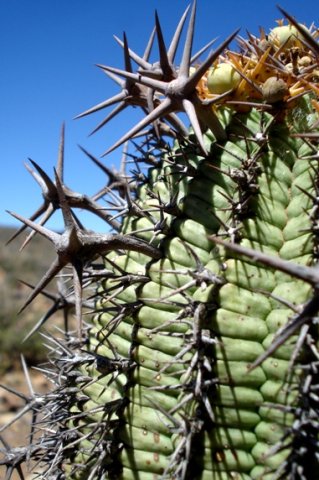Euphorbia stellispina spines

Author: Ivan Lätti
Photographer: Judd Kirkel Welwitch
Contemplation of Euphorbia stellispina focuses the attention on the spines, as the specific name suggests. Shaped like pointed stars, these spines do much to discourage thirsty and hungry herbivores in the arid distribution range of the species to take a bite. Still a sore lip is less than famine.
Survivors generally act in accordance with learnt cause and effect. In this case the equation translates to how much thirst to offset against how much pain and injury. The unyielding, multi-spined units seen on stem ridges here meet standards of the more admirable all-around defence weaponry to be found in the plant world.
Diabolical size differences in these protective units defy strategies of attack, only adding to the challenge presented to attacking lips: Retracting them would be in vain; the resulting injury inside the mouth, where the agony in gums and soft, sensitive parts, as well as broken-off bits among the teeth are sure to prolong the effects of all lessons learnt. Not to speak of spiny heads, still largely intact, being forced down the throat at the first gulp. Still, hungry beggars may be determined chewers!
No wonder the plants are not browsed, or is it grazed at that height? Although heights of 70 cm to 75 cm occur, most stems of plants in nature are well shorter.
E. pillansii is another euphorbia species with branched, star-shaped spines. E. stellispina is a bigger plant though, with more stem ribs (Frandsen, 2017; Smith, et al, 2017; Shearing and Van Heerden, 2008; Van Jaarsveld, et al, 2006; iNaturalist; http://llifle.com).

